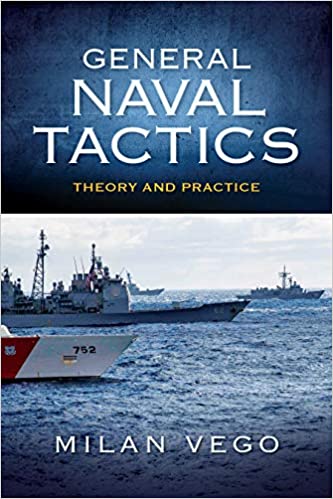Naval Tactics and the Distributed Maritime Force
Professor Milan Vego provides a very helpful look at the tactics of naval forces in his new book entitled, General Naval Tactics: Theory and Practice. The book provides a comprehensive examination of historical and evolving naval tactics and the challenges of delivering combat success.
It is a very comprehensive book which one can learn a great deal about the evolution of naval tactics as well as the challenges facing the adaptation of those tactics to new strategic environments and technologies.
As Vego put it: “As in the past, new weapons and sensors continue to affect methods and procedures in employing naval forces and aircraft to accomplish tactical objectives in war at sea. Thus, the existing tactical methods will be steadily refined or even dramatically changes and completely new tactical methods, unknow today, will emerge.”
I would indeed argue that such change is underway with the US Navy’s focus on distribute maritime operations, kill web integratability with air and ground strike forces and new ISR technologies and new C2 capabilities, driving significant change in terms of integrated distributed operations.
And one always must remember, the nuclear dimension when considering Russia and China, as there is no simple conventional set of operations when confronting a nuclear superpower. That is a subject for its own book, but one increasingly needed to be written with the rise of what Paul Bracken labels the second nuclear age.
The Vego book provides a wide range of insights which can be leveraged to work the question of how the US Navy would actually deliver the kind of combat and crisis management effect desired from a distributed maritime force which has reachback and integratability.
One concept which the author focuses upon which provides a significant way to think about kill web disaggregation and concentration is his discussion of centers of gravity. By focusing on centers of gravity but thinking of them in terms of distributed foci which can be integratable to other maritime or air-maritime, or air-ground-maritime forces packages allows on to focus on how an integrated force package can affect the combat space but expand its impact with reachback to other elements of the multi-domain force.
According to Vego:
“For an attacker, destroying or annihilating the enemy’s center of grav- ity leads to a quick and decisive victory. For a defender, the enemy’s center of gravity must be degraded, avoided, or deceived. A center of gravity is not an objective, geographic location, or city as is too often believed.
“The geographic location means little unless combined with a military force. Center of gravity is not a critical vulnerability, as is logistics, for example. A center of gravity is “a source of massed strength—physical or moral—or a source of leverage whose serious degradation, dislocation, neutralization, or destruction would have the most decisive impact on the enemy’s or one’s ability to accomplish a given objective.” The “mass” does not always mean literally a highly concentrated force. What matters most is the “massed effect,” generated by widely dispersed air or naval forces. At the same time, center of gravity for widely dispersed forces is more difficult to identify and defeat.”
Here is a good opening to the kind of tactical and strategic change which the US Navy could deliver with a distributed maritime force which is integratable with joint forces and allies and partners.
Such a force needs to be able to correlate effectively combat effects with strategic and political purpose to the deployment of the combat force as well.
As Vego put this challenge:
“Any aspect of warfighting is a part of something bigger and more important—and a center of gravity is no exception. Properly understood, a center of gravity is directly linked to a corresponding objective. It is the objective that dominates a center of gravity, not the other way around. Any major change in the objective would require reassessment of the respective center of gravity. Linking the objective and the corresponding center of gravity ensures that one’s efforts are firmly focused on the objective to be accomplished rather than the effects that are generated.
“Without that linkage, a major part of one’s efforts would be misdirected and time would be wasted. Sometimes it is possible to accomplish the objective without destroying the enemy’s center of gravity. Yet that would greatly delay or even preclude consolidation of combat success. The enemy might gain time and regenerate combat potential and then possibly turn the initial defeat or setback into a victory.”
Professor Vego has a very insightful chapter on command and control, and the importance of mission command when distributing the force. Given the speed of modern combat, and the need to have information for decision making at the tactical edge, his discussion of decentralized C2 is especially poignant in terms of the evolution of 21st kill web maritime forces
“Decentralized C2 allows greater flexibility for adapting rapidly to changing battlefield situations, dealing with unforeseen problems, and exploiting fleeting opportunities. It also facilitates a higher operating tempo. Subordinate tactical commanders do not have to pass reports up the chain of command and wait for instructions to be passed down. Instead, they act on their own initiative”
In short, Professor Vego has provided an important book for understanding the history and evolution of naval tactics and by leveraging his work, one can think though how new approaches of the future are being worked and thought through.
My visits to NAWDC and other Naval warfighting centers certainly underscore that such an effort is clearly underway.

